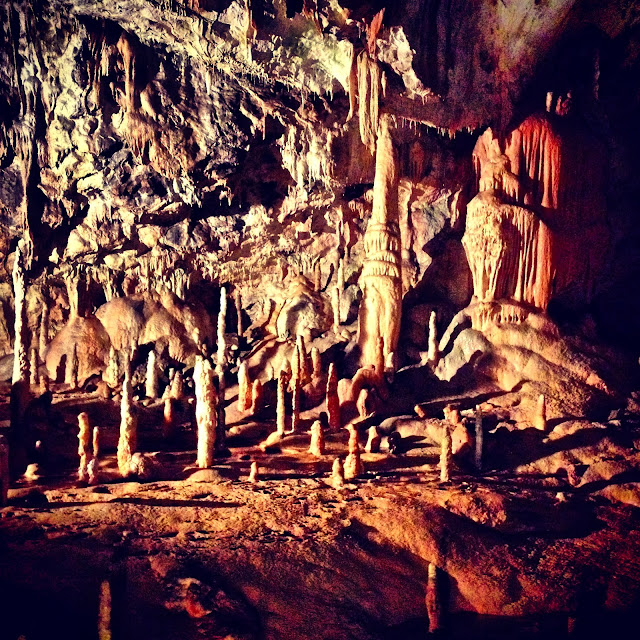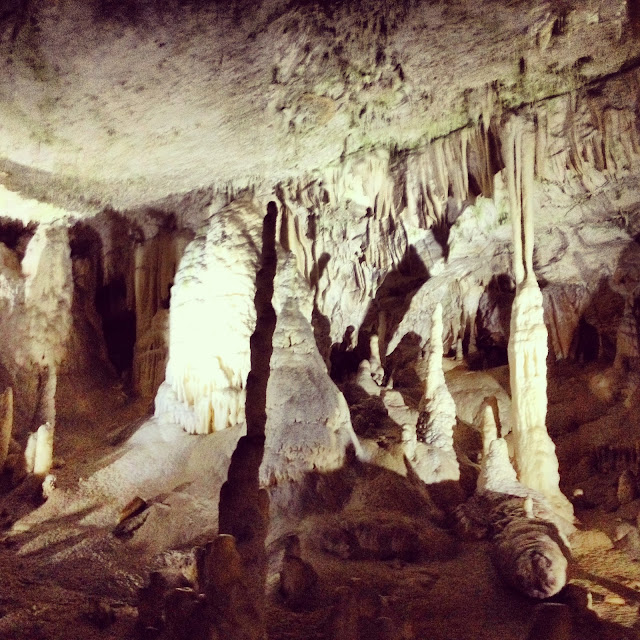Kevin and I visited the world famous cave located in Postojna, Slovenia! It was an extraordinary thing to see!
On the train! part of the tour was by train but most of it was by foot and they have different tours for most languages! In 1872 rails were laid in the cave along with first cave train for tourists.
Postojna Cave is a 20,570 m (67,490 ft) long karst cave system near Postojna, Slovenia. It's the second longest cave system in the country, following the Migocev Cave System.
Postojna Cave is one of the top tourism sites in Slovenia, with more than 28 Million visitors!
The caves were created by the Pivka River, a karst lost river in Slovenia. Karst topography is a geological formation shaped by the dissolution of a layer or layers of soluble bedrock, usually carbonate rock such as limestone or dolomite, but has also been documented for weathering-resistant rocks, such as quartzite, given the right conditions.
The cave was first described in the 17th century by Johann Weikhard von Valvasor. A new area of the cave was discovered accidentally in 1818 by local Luka Čeč, when he was preparing the hitherto known parts of the cave for a visit by Francis I, the first Emperor of Austria.
In 1819, the caves were opened to the public, and Čeč went on to become the first official tourist guide for the caves.
Electric lighting was added in 1884, preceding even Ljubljana, the capital of Carniola, the Austro-Hungarian province the cave was part of at the time, and further enhancing the cave system's popularity.
These ceiling formations are called Stalactites, skinny spaghetti or straw like. Just one drop of water on the ceiling of a cave is all that is needed for a stalactite to start forming. Each drop contains a small amount of dissolved limestone that has been acquired from flowing through the cracks and joints of the bedrock. Once this drop is hanging suspended from the ceiling some of the contained carbon dioxide escapes the droplet. Due to this carbon dioxide escaping, the droplet can’t hold as much limestone so a thin external ring is formed. After the drop falls, a small layer is left as a residual.
After 1945, the gas locomotive was replaced by an electric one. 5.3 km of the caves are open to the public, the longest publicly accessible depth of any cave system in the world.
No matter if its raining, snowing, summer, or winter the cave will always have an interior temperature of 9C (48F) and there is always water dripping on you! If its raining its usually more wet inside!
Stalagmites are formations that are created from the ground up. These formations form from the drops that have fallen from stalactites or dripstones. Even though the drops left some dissolved limestone with the stalactite (dripstone) some still remains in the droplet. As this droplet falls and hits the bottom of the cave or tunnel the droplet scatters. This process allows more carbon dioxide to be lost hence another dripstone formation on the cave floor has begun to form. After many drops have landed on the same spot a stalagmite has formed
Curtain Formation is a thin wavy, folded sheet like mineral deposit that hangs from the ceiling.
To give you an idea of how long these formations have been creating themselves; it may take 120 years or longer for 1 cubic inch of calcite to be deposited on a cave formation.
Columns form after thousands if not millions of years of stalactite and stalagmite formation. When both of these two formations finally grow into one another a column is formed. This as stated earlier can take a very long time and in some cases never happens due to cave or environmental changes occurring.
Do not touch! Touching an active formation causes growth to cease in that area because dirt or oil from your skin prevents water from reaching the growing formation. Enough touches, and the formation will die.
Inside the cave there was a room that was all white followed by a room that was all red! It was really cool to see. Also the pools of water where so clear and still they looked like glass! The water inside the caves is so pure that you are able to drink it!
Sparkly! Very cool formation
The caves are also home to the endemic olm, the largest trogloditic amphibian in the world. The tour through the caves includes an aquarium with some olms in it.
After 3 hours of being in the cave we come out to a snowstorm!
Slovenian Word of the Day:
Jama meaning Cave
PEACE & LOVE,
Kevin & Amanda




















No comments:
Post a Comment